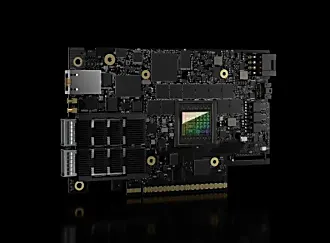Rhys Knipe
on 12 June 2024
Space pioneers: Lonestar gears up to create a data centre on the Moon

In February 2024, Lonestar’s independence mission took the first steps to establish the first data centre on the moon. The company previously worked with Canonical to create a production image that could run in the tight confines of the ISS (International Space Station), with the goal of turning space radiation into art. It was an astronomical challenge, but Canonical delivered an OS that could ensure the mission’s success. In this latest blog, we share how Ubuntu Core helped them chart new territory to achieve their long-term ambition.
Disaster recovery from the lunar surface
A saying appropriate for our age might be, “Where humanity goes, data follows”. Whilst it might sound deep or philosophical, it just means that as a species, we have a big digital footprint. As technology has evolved, data centres have become a sort of collective nerve centre. The transmission of data through them keeps the world ticking along, as our economies, governments and personal lives become intertwined with technology.

That’s why data loss presents such a threat to us as individuals, businesses and societies. How do we recover our data if natural disasters or political instability lead to the destruction of our physical data infrastructure?
Lonestar came to us for help with an ambitious proposition: to establish a data centre on the Moon, as a means of safeguarding humanity’s data. The Moon presents an ideal location for data storage and disaster recovery. In the words of Lonestar founder Chris Stott, “If the Moon didn’t exist, we’d have to build it”.
We were delighted to get on board – both figuratively and literally!
An OS fit for space travel
The requirement from Canonical was to provide a robust OS that Lonestar could tailor to the highly specialised environment you would find on a space vessel.
Ubuntu provided a solid basis for this: not only has Ubuntu been used in space before (check out our recommended reading at the end), but it is known for its high performance in novel situations, particularly in data centres.
However, this alone was not enough: for this mission, Lonestar was pioneering something that had never been tested before. When operating with billion dollar equipment, there’s no room for trial and error. Clocking in at 256 MB, Ubuntu Server and other distributions were too heavy to travel on the hardware that Lonestar were using. It was time to enlist Canonical’s talented field engineers and consider another Ubuntu flavour.
Our Core values
Lonestar needed to travel light, given the restricted amount of space and specific configuration requirements on their chosen hardware. Lonestar needed a minimal OS, which allowed us to use Ubuntu Core, our embedded OS for devices. Ubuntu Core is an immutable, ultra-lightweight version of Ubuntu, which we created to enable device-makers to build and deploy custom production-grade images.
With 5 releases over 8 years, Core offered the additional advantage of maturity. Hundreds of thousands of devices run Ubuntu Core for a diverse range of functions, from smart lockers in Turkey to agricultural monitoring systems in Ecuador.
Having identified the right OS, the next step was to build Lonestar’s production image. Two standard components of any Ubuntu Core custom image are:
- The Kernel Snap, which defines the Linux kernel that runs on the device
- The Gadget Snap, which defines and configures the system properties specific to the chosen hardware
Based on your targeted hardware and application, you can modify both snaps, while still using an OS supported for 12 years. Canonical’s Field Engineers worked with the Lonestar team to create a custom production image with a kernel snap, gadget snap and Lonestar’s custom application on top. Using Ubuntu Core allowed us to provide the minimal OS for the hardware required, whilst still offering the high-performance and versatility associated with Ubuntu. All in all, we were able to create a solution that occupied just 164MB of storage.
Safety and security were also key considerations. Ubuntu Core is naturally secure, with containerised applications that are immutable and operated in strict confinement from one another. If another species were to come across this lunar data store, they wouldn’t be able to access your data. Another important feature to mention is A/B booting, a feature that enables updates to be “rolled back” in the event of a malfunction, without data loss or corruption.
The power of open source
This project was a triumph not just of Lonestar or Canonical, but of open source in general. This is because our challenge went beyond just weight: the hardware chosen by Lonestar (a Microchip Polarfire SoC) was new to the market. This meant that there were no preexisting bootloaders for us to use, nor a kernel repository to provide updates. This is where the power of open source collaboration really comes into play. We were able to create a custom bootloader, using a combination of OpenSBI and UBoot resources. More good news came when we discovered that Microchip had created a public kernel repository.
For anyone interested in a more detailed rundown of how we achieved this, the image we created is publicly available:
https://github.com/dilyn-corner/ubuntu-core-riscv64/releases/tag/icicle-core22
Edge computing at the edge of space
When Neil Armstrong and Buzz Aldrin landed on the Moon in 1969, they planted a flag and left a now indelible footprint. Whilst it’s not a flag, we’re proud that an Ubuntu logo was included as an image on Lonestar’s latest lunar lander. As the technological landscape continues to develop, we’re excited to see where Ubuntu goes next…and how far it may voyage.

We’re also looking forward to working with Lonestar on their next launch, “Freedom”, later this year. We think the name, “Freedom”, fits perfectly with one of Ubuntu’s core values: freedom to participate. For the past 20 years, we’ve striven to make sure that whether you’re a researcher in a small town, a developer in a big company or a galactic visionary in a lab, there’s a platform that enables you to thrive. If you’re interested in harnessing the benefits of open source in a production environment, we’d recommend taking a look at Ubuntu Core. It provides the benefits of robustness and versatility by enabling you to build secure, production-grade images for your devices.
Recommended reading:



